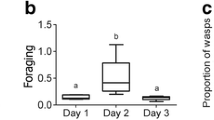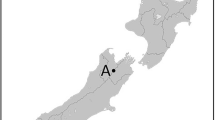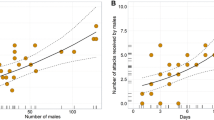Abstract
Physical aggression among nestmates is commonly observed in animal societies like Polistes paper wasps, where it can be used to suppress worker reproduction. There is no consensus about how individuals use aggression in contexts other than reproduction. In order to clarify this topic, the regulation of worker-foraging behavior was studied in the Neotropical eusocial wasp Polistes versicolor. By experimentally manipulating food demand, we found evidence that aggression is used as a decentralized mechanism of regulating foraging, because after food supplementation: (1) aggression levels and foraging rates decreased and (2) aggression received and exhibited by foragers and non-foragers decreased. P. versicolor can use aggression in both reproductive and foraging contexts. The conclusion is drawn that this species is a good model for understanding how individuals differ from aggression related to reproduction and foraging, which would allow understanding of the evolutionary shift in the function of aggression from being the mechanism of reproductive control to being co-opted for the decentralized, self-organized regulation of worker-foraging.


Similar content being viewed by others
References
Arévalo E., Zhu Y., Carpenter J.M. and Strassmann J. 2004. The phylogeny of the social wasp subfamily Polistinae: evidence from microsatellite flanking sequences, mitochondrial COI sequence, and morphological characters. BMC Evol. Biol. 4: 8.
Bruyndonckx N., Kardile S.P. and Gadagkar R. 2006. Dominance behaviour and regulation of foraging in the primitively eusocial wasp Ropalidia marginata (Lep.) (Hymenoptera: Vespidae). Behav. Proc. 72: 100–103.
De Souza A.R., Figueiredo B.B.M., Ribeiro B., Pinheiro R., Justino L., Castro M.M. and Prezoto F. 2011. The performance of three indices to construct dominance hierarchies in Mischocyttarus and Polistes wasps (Hymenoptera: Vespidae). Florida Entomol. 94: 869–873.
De Souza A.R. and Prezoto F. 2012. Regulation of worker activity in the social wasp Polistes versicolor. Insect. Soc. 59: Online first (DOI 10.1007/s00040-011-0204-8).
Gamboa G.J., Wacker T.L., Scope J.A., Cornell T.J. and Shellman-Reeve J.S. 1990. The mechanism of queen regulation of foraging by workers in paper wasps (Polistes fuscatus, Hymenoptera, Vespidae). Ethology 85: 335–343.
Hölldobler B. and Wilson E.O. 1990. The Ants. Springer-Verlag, Berlin.
Hughes C.R. and Strassmann J.E. 1988. Age is more important than size in determining dominance among workers in the primitively eusocial wasp, Polistes instabilis. Behaviour 107: 1–14.
Itô Y. 1985. A comparison of frequency of intra-colony aggressive behaviours among five species of polistine wasps (Hymenoptera: Vespidae). Z. Tierpsychol. 68: 152–167.
Jeanne R.L. 1991. Polyethism. In: The Social Biology of Wasps (Ross K.G. and Matthews R.W., Eds). Comstock, Ithaca. pp 389–425.
Jha S., Casey-Ford R., Pedersen J.S., Platt T.G., Cervo R., Queller D.C. and Strassmann J. 2006. The queen is not a pacemaker in the small-colony wasps Polistes instabilis and P. dominulus. Anim. Behav. 71: 1197–1203.
Kolmer K. and Heinze J. 2000. Rank orders and division of labour among unrelated cofounding ant queens. Proc. R. Soc. Lond. B 267: 1729–1734.
Lamba S., Chandrasekhar K. and Gadagkar R. 2008. Signaling hunger through aggression - the regulation of foraging in a primitively eusocial wasp. Naturwissenschaften 95: 677–680.
Molina Y. and O’Donnell S. 2009. Worker reproductive competition affects division of labor in a primitively social paper wasp (Polistes instabilis). Insect. Soc. 56: 14–20.
Nagamati K.J., Simokomaki K., Gruber C.V. and Del Lama M.A. 2010. Sociogenetic structure of Polistes (Aphanilopterus) versicolor Olivier, 1791 colonies (Hymenoptera, Vespidae, Polistini). Gen. Mol. Biol. 33: 669–675.
Noirot C. and Pasteels J.M. 1988. The worker caste is polyphyletic in termites. Sociobiology 14: 15–20.
O’Donnell S. 1995. Division of labor in post-emergence colonies of the primitively eusocial Polistes instabilis de Suassure (Hymenoptera: Vespidae). Insect. Soc. 42: 17–29.
O’Donnell S. 1998. Effects of experimental foraging removals on division of labor in the primitively eusocial wasp Polistes instabilis (Hymenoptera: Vespidae). Behaviour 135: 17–193.
O’Donnell S. 2001. Worker biting interactions and task performance in swarm-founding eusocial wasp (Polybia occidentalis, Hymenoptera: Vespidae). Behav. Ecol. 12: 353–359.
O’Donnell S. 2003. The development of biting interactions and task performance in a tropical eusocial wasp. Behaviour 140: 255–267.
O’Donnell S. 2006. Polybia wasp biting interactions recruit foragers following experimental worker removals. Anim. Behav. 71: 709–715.
Oliveira S.A., Lopes J.F.S. and Prezoto F. 2006. Dominance hierarchy in different stages of development in colonies of the neotropical eusocial paper wasp Polistes versicolor (Hymenoptera, Vespidae). Sociobiology 48: 515–526.
Pardi L. 1948. Dominance order in Polistes wasps. Physiol. Zool. 21: 1–13.
Reeve H.K. 1991. Polistes. In: The Social Biology of Wasps (Ross K.G. and Matthews R.W., Eds). Ithaca, Cornell University Press, pp 99–148.
Reeve H.K. 1992. Queen activation of lazy workers in colonies of the eusocial naked mole-rat. Nature 358: 147–149.
Röseler P.F. 1991. Reproductive competition during colony establishment. In: The Social Biology of Wasps (Ross K.G. and Matthews R.W., Eds). Cornell University Press, Ithaca, pp 309–335.
Smith A., O’Donnell S. and Jeanne R.L. 2001. Correlated evolution of colony defense and social structure: a comparative analysis in eusocial wasps (Hymenoptera: Vespidae). Evol. Ecol. Res. 3: 331–344.
Sumana A. and Starks P.T. 2004. The function of dart behavior in the paper wasp, Polistes fuscatus. Naturwissenschaften 91: 220–223.
Strassmann J.E. 1981. Evolutionary implications of early male and satellite nest production in Polistes exclamans colony cycle. Behav. Ecol. Sociobiol. 8: 55–64.
West-Eberhard M.J. 1969. The social biology of polistine wasps. Misc. Publ. Mus. Zool. Univ. Michigan 140: 1–100.
Acknowledgments
We thank J. Strassmann, F.S. Nascimento and the anonymous reviewer for the helpful comments on the manuscript. This work was supported by Fundação de Amparo a Pesquisa do Estado de Minas Gerais (FAPEMIG).
Author information
Authors and Affiliations
Corresponding author
Rights and permissions
About this article
Cite this article
De Souza, A.R., Prezoto, F. Aggressive interactions for a decentralized regulation of foraging activity in the social wasp Polistes versicolor . Insect. Soc. 59, 463–467 (2012). https://doi.org/10.1007/s00040-012-0240-z
Received:
Revised:
Accepted:
Published:
Issue Date:
DOI: https://doi.org/10.1007/s00040-012-0240-z




